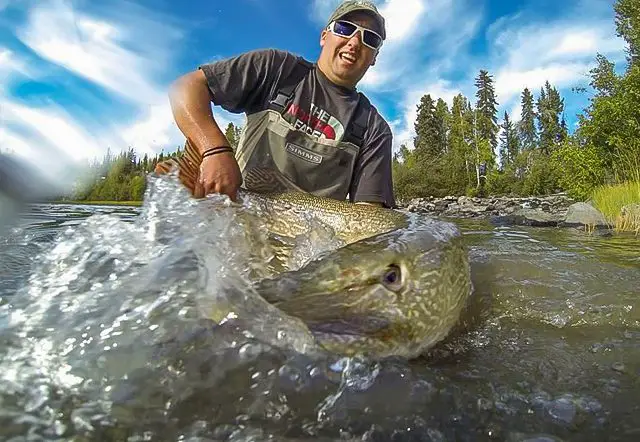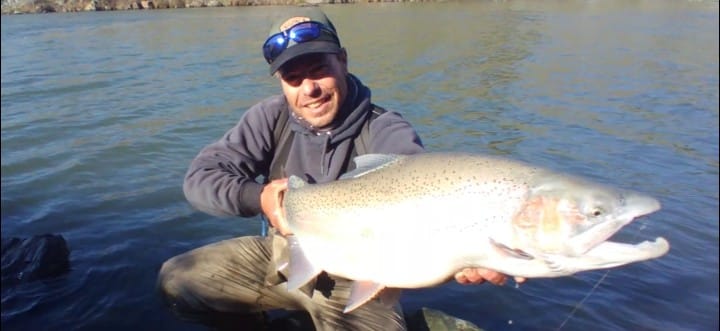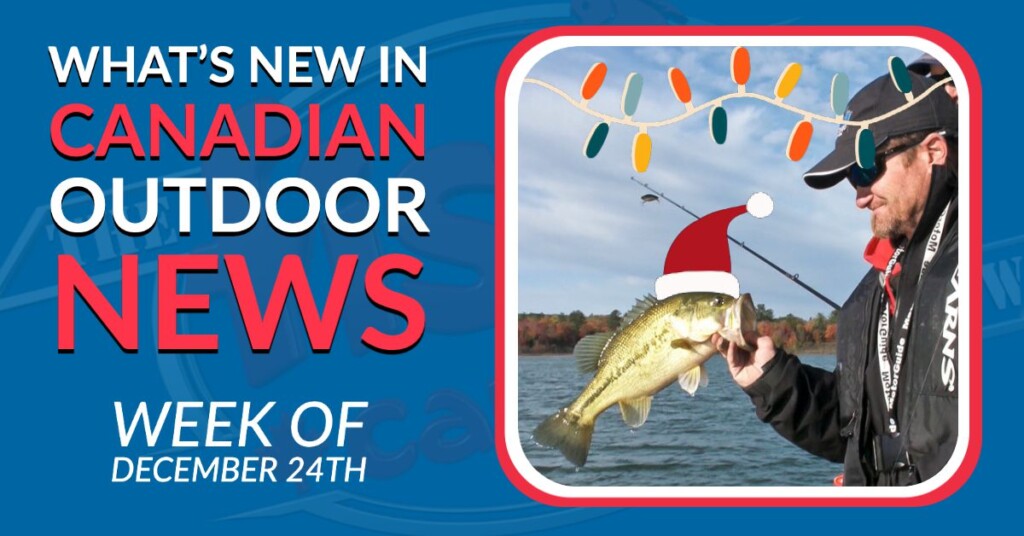The Stories that Matter and the Fuel to your Bar Banter – Canadian Hunting and Fishing News from the Week of December 24th, 2021
Although news has never been so abundant, finding relevant and reliable stories has never been more difficult. Thankfully, Fish’n Canada has you covered. From Largemouth farms to fishing bans, here are all the stories from this week that matter to the Canadian outdoorsman!
1. B.C. man receives lifetime fishing ban

In what could amount to one of the largest personal fisheries violations in Canadian history, a B.C.man has been given a rare lifetime ban from fishing after multiple violations of Canada’s Fisheries Act.
According to CTV News Vancouver Island, the punishment is so rare, in fact, that this is the first time it has been dealt in the Pacific region in over a decade.
The list of violations that led to this punishment is long and growing. Since 2008, the man, Scott Steer, has been involved in 15 different DFO investigations and has had four boats and two vehicles seized in the process. More recently, Steer was caught illegally fishing for crab in Vancouver, resulting in a high-speed pursuit with the DFO, six months in jail, another boat confiscation, and now two-lifetime fishing bans.
According to the DFO, the two other crew members involved in the Vancouver Harbour incident have been convicted or pleaded guilty to violations of the Fisheries Act and will receive sentencing in early 2022.
2 – Canadian study shows that fish recover rapidly from mercury pollution

A study out of northwestern Ontario caught our eye this week as it shows that mercury pollution may not have quite as long an impact as once thought.
In this promising experiment, researchers visited Ontario’s Experimental Lakes, an area near the town of Kenora dedicated to freshwater fisheries research. Here, for seven years, researchers added various forms of mercury to the lake. These various forms of mercury were designed to be distinguishable from naturally occurring mercury, allowing the researchers to replicate a pollution source.
During this seven-year experiment, researchers found that methylmercury concentrations, the harmful form of mercury that concerns most fish-eaters, rose by 45 to 57 percent in lake-dwelling invertebrates and small fish, and more than 40 percent in larger fish. After the mercury introduction ceased, however, things took a turn for the better – and quickly.
According to PopSci.com, shortly after stopping the mercury introduction “the team found that the isotopes they’d introduced decreased by 81 percent in lakewater, 35 percent in lakebed sediments, and 66 percent in tiny zooplankton within three years. By the end of the experiment, methylmercury made from these isotopes had dropped more than 85 percent in small fish, 76 percent in pike, and 38 percent in whitefish populations.”
While these numbers are promising, it is important to note that these declines in mercury levels were representative of the population as a whole and that individual fish that contained high levels of mercury appeared to take much longer to see their levels drop. This is especially true of long-lived, slow to reproduce species such as Whitefish due to a process called bioaccumulation.
For more on bioaccumulation and mercury levels in fish, check out the article linked below!
3 – No coyote attacks in Stanley Park since September cull

As we reported earlier in the year, Vancouver’s Stanley Park had been seeing record high coyote incidents, with 45 attacks being reported between December 2020 and September 2021.
These attacks all came in just a four square kilometre range and were all linked to human feeding. Due to how widespread and severe this problem had become, local conservation authorities had determined that lethal measures were the only option for these highly food-conditioned animals. “The decision to lethally remove the coyotes was not the province’s first choice, and only comes after considerable effort into finding other alternatives to prevent the incidents,” said a statement from the ministry shortly after the attacks.
This decision, however, did not go through without controversy, and even celebrities the likes of Bryan Adams got involved and contributed to the backlash.
Culling of coyotes in Stanley Park? Consider the knock on effect by removing a species from its natural habitat. Look what happened when they wiped out the wolves in Yellowstone. They had to rewild them back to balance the ecosystem. #banthecull #coyotes #StanleyPark #Vancouver
— Bryan Adams (@bryanadams) September 5, 2021
Despite the backlash, the ministry carried out their decision and all problem coyotes were lethally removed from the park. Thankfully, the effort appears to be a success as zero coyote conflicts have since been reported, despite coyote sightings remaining at a steady level.
“People have seen them from a distance and they run away when people are around, which is very encouraging,” said Nadia Xenakis, the urban wildlife program coordinator for SPES in an interview with CBC. “That’s how coyotes should be behaving in Stanley Park.”
As of October, the park has also made it illegal to feed any wildlife within the park, a law that hopes to keep human-animal conflicts at a comfortable low and avoid another situation like we saw this fall.
4 – Is aquaculture Largemouth now on the menu?

At a recent meeting of the Florida Fish and Wildlife Commission, new laws began being drafted that are set to put one of the most sought-after gamefish species in the country on menus across the state – the Largemouth Bass.
The proposal would essentially make the sale of Largemouth Bass for the purposes of food legal in the state of Florida and would also allow for a bass-based aquaculture industry to establish itself in the state. This proposal began back in October of this year when it was floated to stakeholders and is now being proposed in its final form. The law, in its current language, can be found below:
- Allow for the culture and sale of Florida largemouth bass as a food fish.
• Incorporate FWC’s Genetic Authentication Standards for Florida largemouth bass into rule by reference.
• Prohibit the importation into or transportation within the state of any live bass species, except Florida largemouth bass that meet FWC’s largemouth bass Genetic Authentication Standards.
• Require any shipment of live bass in Florida to be accompanied with documentation required by the Florida Department of Agriculture and Consumer Services Aquaculture and FWC.
In response to anglers concerns over the potential of aquaculture fish entering prestigious waterways, the FWC has stated that “staff will remain vigilant and maintain dialogue with FDCAS to ensure that this emerging industry for largemouth bass does not negatively impact Florida’s largemouth fishery,” (Erik Sutton, FWC).
For those unfamiliar with aquaculture’s impact on fisheries, check out the article below to see how escaped aquaculture salmon in Nova Scotia have infiltrated wild stocks.
In terms of raising and eating Largemouth, we here at Fish’n Canada have some opinions.
“As a kid, I remember eating largemouth once,” says Pete Bowman “and I obviously wasn’t impressed with the outcome since I haven’t tried it again. And that was a northern strain bass from cool, Canadian waters. To convince me of chomping down on a feed of Florida strain bass that are pen-raised in 70-80+ degree water… I guess time will tell as to the quality of that meal. Until then, I’ll stick to sushi!”
“And as far as escapees and accidental movement of fish” Angelo Viola continues, “It’s a tough one to contain at a 100% level. Contained Carp accidentally filtered throughout North America due to flooding. What about the Rainbow Trout in Parry Sound? Our west coast Salmon population is now a total mixture of wild vs. cultured fish. These are but a few of many examples.
“And finally to the point of the local anglers justified concerns over the potential of aquaculture Largemouth entering prestigious waterways” our guys continue, “the plan and execution better be perfect because you DO NOT want to mess with the Florida bass-boys and their playgrounds… just sayin’!”
5 – Angler releases potential record-Rainbow to avoid killing it

Josh Giordano, a Northern California native, has perhaps crowned himself the “king of catch and release” after releasing a potential record Rainbow to avoid having to kill it.
Measured on the shore at 41″ with a 29″ girth, the fish is projected to have weighed a whopping 38.2-pounds.
“When I hooked this fish I knew immediately how giant it was when it peeled off 150 yards of line in about 20 seconds,” he told the Stockton Record. “I have never seen the power of a fish like it. The fish continued to jump, tail walk and do things I’ve never seen fish do on the surface.”
Giordano said that the bait of the day was a swimbait.
As many are aware, for record-breaking fish to become official, anglers must have them weighed on an official scale, often in front of witnesses. This often takes place hours after the catch, meaning the fish must be killed to make the record books.
When asked why he decide to release the fish, Giordano stated that he released it “because of the respect I have for them, but also in hopes that one of our young upcoming anglers has a shot at becoming a legend or even a record holder.”

Would you have done the same? Let us know in the comments below!
Have a story we missed? Send us an email at [email protected]








